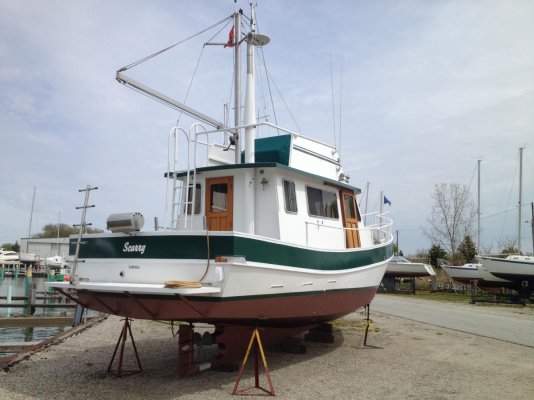I talked with the marina today and the hull has been pressure washed and looks good, no blisters or other problems. They are going to blast off all the paint to the gelcoat do 4 coats of the interprotect 2000 barrier and then what ever bottom paint I choose. The blasting will happen Monday then it'll be blocked up in the shop and the other projects done and all the coating and painting will happen when it's warm enough in the spring before its launched. At this time I'am leaning towards Trinidad or Ultra and will make the final decision after I know both are compatible with the barrier coat.
Just a heads up to make sure the yard/marina carefully follows your instructions for applying bottom paint over the Interprotect 2000. I had a problem with bottom paint flaking off because I let the barrier coat completely cure (slick and hard) over the winter before applying bottom paint. The Interlux tech guys subsequently advised that I should sand off the flaking bottom paint (thereby also roughening the epoxy), apply a single tack coat of fresh 2000, and then apply the bottom paint while the epoxy was "thumb print" tacky. That will give a chemical as well as mechanical bond for the bottom paint. I elected to use a hard red Interlux bottom paint for the first coat, followed by two coats of Interlux black ablative. Their tech guys said it would work fine as long as I also followed the over coat times for the bottom paints (basically overnight) Make sure the yard knows this and plans accordingly. They should not apply the last coat of epoxy and quit for the day. Yes, the epoxy stays "open" for a longer period, but if you want the
best job, again, apply the bottom paint when it's tacky. Our 44 foot boat had to be done in four sections....epoxy/red bottom paint...epoxy/red bottom paint, etc...because the epoxy very quickly cured beyond the thumb print stage. No way could one person realistically keep up...and it was a challenge for two of us ...one applying the paint and one alternately prepping batches of epoxy, then bottom paint. Two sets of paint trays/applicators, etc.
I chose ablative for the last two coats because the boat is on the Great Lakes and gets hauled every winter. The ablative will reactivate when splashed, where none of the hard paints (that I know of) will work after being hauled for an extended period....maybe the Coppercoat...
The Interlux ablative has been on the boat since 2008 and with the exception of the water line, I still have not seen the red guide coat emerging. I touch up the water line area every two years as it gets a lot of brushing to remove the scum line. That said, the boat has not seen a lot of hours underway in recent years. Except for the water line, there is virtually zero growth on the bottom...Northwest coast of Michigan, four months of each year in the water. Each Fall I carefully power wash the bottom myself as I don't trust the kids in the yard not to blow off the ablative paint.


